What Is a Company Mission Statement and How Can You Create Your Own?

To organize the world’s information and make it universally accessible and useful.
To give people the power to share and make the world more open and connected.
To empower every person and every organization on the planet to achieve more.
Can you guess the famous companies based on the openings of their mission statements? Mission statements like these (Google, Facebook, and Microsoft, respectively) sum up each company’s objectives, strategy, and values.
Whether you are just starting out with a new business or rethinking your current goals, mission statements are effective ways of saying a lot with a few words. They demonstrate your organizational values to both your employees and the general public.
What is a company mission statement?
A mission statement isn’t simply stating your company’s desire to be the best in your field or make the best product. Instead, it is a way of showing what makes your company stand out and what makes its future so bright.
In addition to stating your company’s values and purpose, mission statements can also include a number of other elements. They can convey your targeted customers, position within your market, and quantitative objectives, among other things.
When writing a mission statement, it is important to understand the balance between the mission statement as a part of your company’s public image and the mission statement as a part of your company’s internal communications.
The purpose of a company mission statement and how to write one
Powerful mission statements can be vitally important to your company in a number of different ways. Next, we’ll look at seven ways that can help you write the perfect mission statement based on your goals.
1. Mission statements guide the company forward
Mission statements are an incredibly important navigational tool when you are thinking about the future of your company.
By identifying the purpose of your work, you can better understand the goals your company should be committed to accomplishing. Once those goals are set, you and your team can develop a sound strategy to achieve them. By having this strong foundation, you can build your organization from the ground up and ensure its stability through the challenges ahead.
READ MORE: How Howard Behar Used Company Values to Build Starbucks’ Culture
The mission statement is the bedrock of any organization. Make sure it’s as strong as it needs to be. You, your team, and your partners will turn to this as a guideline for all actions. At the same time, potential customers can judge your brand based on its mission statement to decide whether it suits their own values or not.
2. Mission statements focus your energy and attention
The mission statement shouldn’t just be your beginning. It should stay with you through every decision you make as you work toward your goals.
The simplicity of the mission statement requires you to isolate only the most important part of your company’s purpose. By developing a mission statement, you must evaluate every option and decide what will best suit your company and its future. By talking through your decision process with the mission statement, you can help your team work through problems and ideas.

The mission statement opens this communication and can refocus a team that has been pulled apart in too many different directions.
-1.jpg?width=531&name=pasted%20image%200%20(1)-1.jpg)
3. Mission statements spark new ideas
While you are discussing and considering your mission statement, it may open you up to new ideas. In fact, here’s where the true value of getting everyone on board to contribute to the mission statement development process lies.
While it is important to have a solid foundation, the mission statement can also shift your perspective on your work. It can cause you to look at your company with a fresh set of eyes.
That being said, a mission statement can always be changed over time, enabling you to adjust your statement in new directions that better suit your team and your own business goals.
It is, if you will, part of the ideation process and it brings together multiple opinions and beliefs that every single member of your company can provide.
4. Mission statements shape company culture
Mission statements not only dictate how an organization as a whole should act, but also how individual employees think about their jobs.
Company culture is a crucial aspect of employee happiness. Remove some of the uncertainty in their jobs by clearly explaining your company’s purpose and your organizational values. Employees will know before they start working at your organization exactly what is expected of them. They can then customize their work to fit your mission and get effective results across different departments.

Your mission statement will also attract job seekers whose values align with your own. Since this is another recruiting tool you have at your disposal, make full use of it by incorporating it in job descriptions and throughout the entire hiring process.
Exposing new hires to your mission statement in action — as well as core company values during the onboarding process — helps you ensure cultural fit and maintain high retention rates in the future.
5. Mission statements establish consistency
As you grow your company, you will start establishing many different departments and hiring new employees.
Every step in growing your company runs the risk of losing your focus and your unique culture. Mission statements can stop this mission creep in its tracks.
Everyone knows the mission statement. Everyone has something to refer to when making an important decision. Mission statements can make sure that each individual facet of your organization is working in concert with one another.
To establish this consistency, mission statements should be as clear as possible. Make sure that there is no room for incorrect interpretation.
For the best results, have someone else review the mission statement before making it public or get your entire team to voice their own thoughts on it.
-1.jpg?width=531&name=pasted%20image%200%20(2)-1.jpg)
6. Mission statements send out a powerful message to the public
Mission statements aren’t merely a form of important internal communication. They’re one of the strongest messages you can send to the public.
Consumers and clients will find the mission statement to be an effective encapsulation of your values. If you believe your mission statement does not represent these values or does not reach the audience you intended, it’s time to reevaluate it.
The statement should convey your company’s passion and vision in a way that intrigues or reassures the general public. When you look back at the introductory examples of mission statements, you’ll notice that they encompass broad ideals and goals.

For example, Google’s mission statement doesn’t mention its product. Instead, it focuses on its intentions.
This idea leads to the last and most important purpose of a mission statement.
7. Mission statements drive action
Mission statements are oriented around actions. They’re by no means not created just for the sake of having one. Instead, they’re centered around the #1 thing you want your company and team to achieve.
It may be the intention of your company to create an outstanding product. But that isn’t enough. What is your mission? How is your product going to make consumers’ lives better?
Mission statements are a way of making this clear. They cut through the noise and get straight to the heart of your company’s passion and vision. Exciting, energetic mission statements show the public your company’s dedication and determination. They form a vital aspect of your communications.
10 examples of incredible company mission statements
When it comes time to craft your mission statement, don’t worry about starting from scratch.
Companies that are known for their strong organizational values and vision have already created perfect mission statements that you can use as inspiration. The key to having a one-of-a-kind mission statement is to analyze what your core needs are and ensure you stay authentic — even as you compare yourself to other brands.
With that in mind, here are 10 company mission statement examples from different types of organizations that are already using them for employer branding or market positioning.
1. Buffer
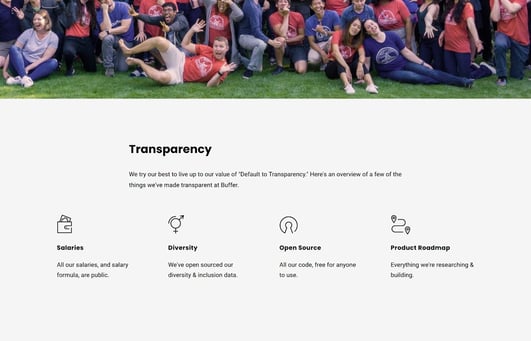
Buffer’s mission statement is all about its work culture and the team environment they create. Their belief is that good customer service starts with ensuring all team members are the right cultural fit and support similar values.
Transparency, positivity, and gratitude are just three of the fundamental ideas that define the way they work and interact both with one another and with their clients. These efforts of crafting the perfect mission statement have proven successful as they’ve used them to their full potential for employer branding. A perfect example of a simple mission statement that’s responsible for a 94% retention rate.
2. sweetgreen

sweetgreen’s mission to support healthier communities is visible throughout all of their activities — from the food they’re selling to the causes they support.
Notice how this particular mission statement focuses on bringing together multiple parties to ensure a united community. They use their complex mission of connecting growers and consumers through storytelling as they create an ideal that people can relate to. This way, sweetgreen and its clients can both share the same mission.
3. TINYpulse
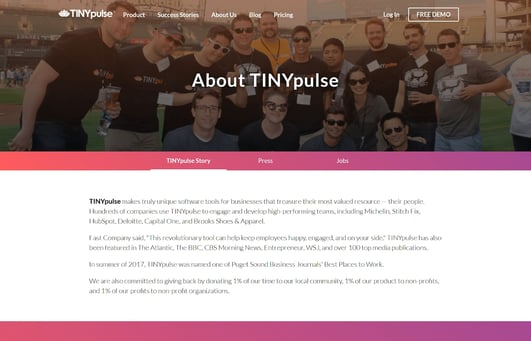
At TINYpulse, we support our mission of having happier employees by following our very own DELIGHT framework:
- Delight customers
- Elect to spread positivity
- Lead with solutions and embrace change
- Increase communication with transparency
- Go the extra mile with passion
- Hold oneself accountable
- Treasure culture and freedom
This is a perfect example of how your company mission can start with a general idea. But you’ll need to craft specific values to make that mission a reality.
4. Uber

Mission statements don’t have to be complicated. You don’t need to feel pressured into promising something out of this world.
Uber’s mission is simple: igniting opportunity by setting the world in motion. They take their service and find its main use.
Motivating people to go for their dream can be as simple as making it easier for them to move from one place to another. Find why your customers need your product and make that your mission statement.
5. Patagonia
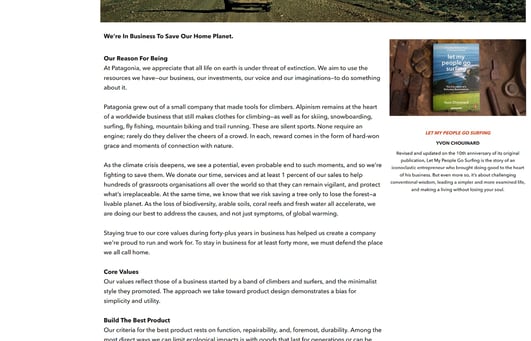
Patagonia takes their company mission beyond the individual to support a cause many of us are already involved in: saving the planet.
Environmental issues perfectly fall among the core ideas that Patagonia’s regular customers support — including going back to nature and protecting our environment.
This mission statement example comes off as authentic as it lies at the foundation of the company. Not to mention that Patagonia has been donating 1% of their earnings to the preservation and restoration of the natural environment ever since 1985.
6. TED
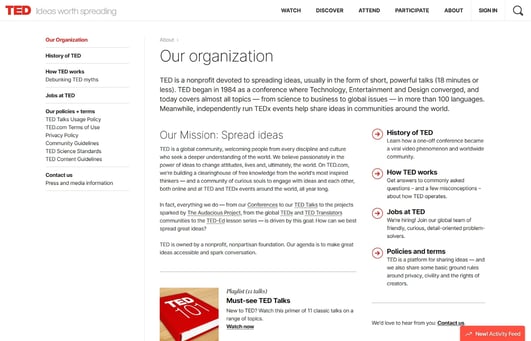
You might already be familiar with TED’s mission if you’ve ever watched TED Talk or read one of their articles.
Their purpose is a simple yet highly-appreciated one: spreading ideas. They aim to make it easy for people to have access to knowledge regardless of where they are in the world.
That’s why it’s free to watch their Talks online, and each of them are translated into several languages so no one misses out on a genius idea.
7. Chobani

Companies that are part of highly competitive markets might find it more difficult to come up with a unique mission statement. So what can a yogurt company like Chobani do?
Aim to become the best company ever.
Chobani promises to offer better and innovative products along with turning their own organization into “the kind of company we want to see in the world.”
This implies giving back the community that supports their efforts and making an impact by providing financial support to the causes that are aligned with their values.
8. Southwest Airlines
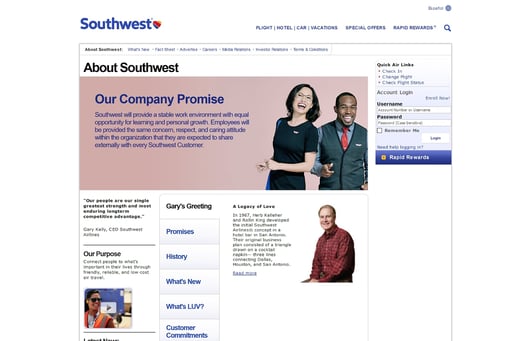
The most straightforward way of looking at a mission statement is by having the customer in mind.
Southwest Airlines have taken this approach by promising to offer a “stable work environment with equal opportunity for learning and personal growth.” The belief is that by treating employees appropriately, they’ll be able to display the same level of respect and care when interacting with customers too.
This mission statement connects two parties to show the value placed on all the people who get to interact with the company.
9. American Red Cross
Sometimes the mission statement is easy to craft because it’s also the reason the company was founded to begin with.
NGOs and humanitarian organizations perhaps know this better than anyone else.
Case in point? The American Red Cross aims to “prevent and alleviate human suffering in the face of emergencies.” Their entire existence revolves around bringing volunteers and donors together to help with this goal. In other words, their very mission starts and ends with people in mind as humanity is their first principle.
10. IKEA

A mission statement example that targets everyone?
That’s what IKEA created when they set out to improve the lives of people all around the world — from selling affordable furniture and accessories and ensuring that their own workers and partners are treated well.
These types of goals can turn your brand into one that appeals to larger audiences.
Everybody wants a better life, so why not make this promise as long as you can keep it? Make sure you never build a mission statement you can’t work towards achieving or else you’ll lose your genuine image.
Ready to write your mission statement?
You should be mindful of your mission statement during each step of the company-building process. At the end of the day, your mission statement determines your beginning, it determines your growth, and it determines your future.

Mission statements can be incredibly powerful and you should think carefully before creating yours. These simple phrases and ideas force you to consider the current trajectory of the company and the image it presents to the world.
At the end of the day, mission statements inspire your employees to reach their full potential and attract new audiences that are aligned with your causes.
In this light, mission statements have the power to make or break your company. Choose wisely!















![Toni Kroos là ai? [ sự thật về tiểu sử đầy đủ Toni Kroos ]](https://evbn.org/wp-content/uploads/New-Project-6635-1671934592.jpg)


